5 Factors That Affect the Packaging Procurement Timeline
Packaging is an essential component of product marketing. Not only does it protect the product in transport and display, decorated packaging also acts as a helpful communication and marketing channel between brands and customers.
Since product packaging is a crucial part of manufacturing, any modifications in packaging operations and supply chain management can negatively impact business operations. A notable example of this would be the extended lead time for packaging procurement.
Your business depends on other companies in your supply chain to complete your products. That’s why it’s crucial to know and understand how long it takes for each of your vendors to get your product components to you and the factors that may affect their potential delay. Since packaging is a critical part of your supply chain, you must be aware of any changes to adapt, respond, and maintain business continuity efficiently.
This article breaks down the various factors involved in the packaging timeline. It’s worth taking note of how product procurement works and the facets that can affect your operations.
Factors Affecting Your Packaging Procurement Timeline
- Market demand
What your packaging supplier can produce in a few weeks may take them longer several months later, depending on the demand of their customers and vice versa. When suppliers run with high demand, there can be cases where some retailers don’t get the parts they need for their packaging when they expect it.
The influx of demands for packaging materials can lead to scarce supplies and increased prices for materials. Since this can also affect the overall packaging cost, some retailers are forced to use other product solutions. For example, the high demand for cardboard packaging can temporarily motivate businesses to use alternative materials like plastic.
For brands that have an established relationship with their suppliers, a practical workaround without compromising quality is communicating with the suppliers to see what they can provide that you can use. When trusted suppliers know your product in detail, they may help find practical solutions to ensure your supply chain operates efficiently despite delays.
- Supplier location
Your suppliers’ geographic locations and their proximity to your distribution facility can help you gauge how long it will take for your packaging to arrive. Some businesses source their packaging overseas, while others work with local vendors.
Working with a local supplier can help reduce the timeline for procurement, but it’s important to consider your regional factors. For instance, weather or shipping port bottlenecks can directly affect your packaging lead time. If you choose to purchase your packaging overseas, you must account for customs and international shipping in your timeline.
- Multiple manufacturers
Another thing to consider is whether your product requires packaging parts from multiple vendors. Consider the location and lead time of the various suppliers to determine the minimum, maximum, and probable lead time.
Know that every supplier has its own manufacturing process. Some may use a more traditional approach, while others may be using cloud-based managing and tracking systems. When one manufacturer encounters a problem, it can cause a domino effect on your project, putting your project on hold.
Make sure that your supplier’s manufacturing process can meet your demand. For instance, a reliable print provider should be able to produce quality printing at high speed and low running costs, regardless of the type of printing your packaging needs.
- Unpredictable shipping delays and production shutdowns
Delays are common, unpredictable, and difficult to control in construction projects. Several factors can affect longer lead times and slow down supplier deliveries, including port congestion, labor constraints, production shutdowns, and transportation congestion.
For example, longer lead times can occur because of productions shutting down due to a storm or lockdown mandate, perhaps because of COVID-19. Some suppliers are finding creative solutions to port congestion or transportation challenges, such as rerouting shipments to airfreight and accounting for unexpected delays in the supply chain management.
- Material shortages
Material shortages and delays are some of the significant causes for delays in project delivery. During the pandemic, when more customers shop online and have their purchases delivered at their doors, the demand for corrugated packaging increased, and its scarcity followed. This led some businesses to panic-buying cardboard supplies.
Another challenge that could impact packaging procurement is if a material is difficult to source. Packaging suppliers wouldn’t take a contract if they couldn’t meet the demand. If a supplier decides to take on one and fails to source materials within the given time frame, it could affect its operations.
Ensure Orders Go Where They Need to Go
Changes in procurement and supply chains happen, often unexpectedly. It all comes down to how your brand handles these setbacks productively for the future. Challenges like stockouts can encourage companies to rethink better packaging solutions that are more flexible moving forward.
For efficient and seamless business operations, especially with product procurement, it’s essential to maintain good communication with your suppliers throughout the process. It’s also vital to manage expectations to ensure both parties are on the same page.
Ensure you’re working with reliable packaging vendors for quality and seamless product results. If you need help with packaging design, reach out to our experts at Meyers Printing for professional printing solutions.

